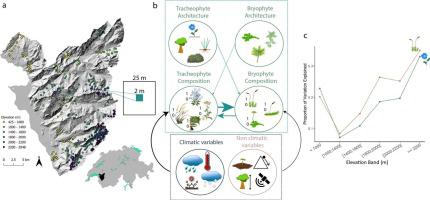当前位置:
X-MOL 学术
›
Sci. Total Environ.
›
论文详情
Our official English website, www.x-mol.net, welcomes your feedback! (Note: you will need to create a separate account there.)
To what extent can we predict variation of bryophyte and tracheophyte community composition at fine spatial scale along an elevation gradient?
Science of the Total Environment ( IF 9.8 ) Pub Date : 2024-03-19 , DOI: 10.1016/j.scitotenv.2024.171741 Flavien Collart , Thomas Kiebacher , Marion Quetsch , Olivier Broennimann , Antoine Guisan , Alain Vanderpoorten
Science of the Total Environment ( IF 9.8 ) Pub Date : 2024-03-19 , DOI: 10.1016/j.scitotenv.2024.171741 Flavien Collart , Thomas Kiebacher , Marion Quetsch , Olivier Broennimann , Antoine Guisan , Alain Vanderpoorten

|
Mounting evidence points to the need for high-resolution climatic data in biodiversity analyses under global change. As we move to finer resolution, other factors than climate, including other abiotic variables and biotic interactions play, however, an increasing role, raising the question of our ability to predict community composition at fine scales. Focusing on two lineages of land plants, bryophytes and tracheophytes, we determine the relative contribution of climatic, non-climatic environmental drivers, spatial effects, community architecture and composition of one lineage to predict community composition of the other lineage, and how our ability to predict community composition varies along an elevation gradient. The relationship between community composition of one lineage and 68 environmental variables at 2-25 m spatial resolution, architecture and composition of the other lineage, and spatial factors, was investigated by hierarchical and variance partitioning across 413 2x2m plots in the Swiss Alps. Climatic data, although significant, contributed less to the model than any other variable considered. Community composition of one lineage, reflecting both direct interactions and unmeasured (hidden) abiotic factors, was the best predictor of community composition of the other lineage. Total explained variance substantially varied with elevation, underlining the fact that the strength of the species composition-environment relationship varies depending on environmental conditions. Total variance explained increased towards high elevation up to 50 %, with an increasing importance of spatial effects and vegetation architecture, pointing to increasing positive interactions and aggregated species distribution patterns in alpine environments. In tracheophytes, an increase of the contribution of non-climatic environmental factors was also observed at high elevation, in line with the hypothesis of a stronger environmental control under harsher conditions. Further improvements of our ability to predict changes in plant community composition may involve the implementation of historical variables and higher-resolution climatic data to better describe the microhabitat conditions actually experienced by organisms.
中文翻译:

我们可以在多大程度上预测苔藓植物和气管植物群落组成在精细空间尺度上沿海拔梯度的变化?
越来越多的证据表明,全球变化下的生物多样性分析需要高分辨率气候数据。然而,随着我们迈向更精细的分辨率,气候以外的其他因素,包括其他非生物变量和生物相互作用,发挥着越来越大的作用,这提出了我们在精细尺度上预测群落组成的能力的问题。着眼于陆地植物的两个谱系——苔藓植物和气管植物,我们确定了气候、非气候环境驱动因素、空间效应、群落结构和一个谱系的组成对预测另一个谱系的群落组成的相对贡献,以及我们如何预测另一个谱系的群落组成。预测群落组成沿海拔梯度变化。通过瑞士阿尔卑斯山 413 个 2x2m 地块的分层和方差划分,研究了一个谱系的群落组成与 2-25 m 空间分辨率下的 68 个环境变量、另一个谱系的建筑和组成以及空间因素之间的关系。气候数据虽然很重要,但对模型的贡献小于任何其他考虑的变量。一个谱系的群落组成反映了直接相互作用和未测量(隐藏)的非生物因素,是另一谱系群落组成的最佳预测因子。总解释方差随海拔的变化而显着变化,强调了物种组成与环境关系的强度根据环境条件而变化的事实。随着空间效应和植被结构的重要性日益增加,高海拔地区的总方差解释增加至 50%,这表明高山环境中积极的相互作用和聚合物种分布模式不断增加。在气管植物中,在高海拔地区也观察到非气候环境因素的贡献增加,这符合在更恶劣的条件下更强的环境控制的假设。进一步提高我们预测植物群落组成变化的能力可能涉及历史变量和更高分辨率的气候数据的实施,以更好地描述生物体实际经历的微生境条件。
更新日期:2024-03-19
中文翻译:

我们可以在多大程度上预测苔藓植物和气管植物群落组成在精细空间尺度上沿海拔梯度的变化?
越来越多的证据表明,全球变化下的生物多样性分析需要高分辨率气候数据。然而,随着我们迈向更精细的分辨率,气候以外的其他因素,包括其他非生物变量和生物相互作用,发挥着越来越大的作用,这提出了我们在精细尺度上预测群落组成的能力的问题。着眼于陆地植物的两个谱系——苔藓植物和气管植物,我们确定了气候、非气候环境驱动因素、空间效应、群落结构和一个谱系的组成对预测另一个谱系的群落组成的相对贡献,以及我们如何预测另一个谱系的群落组成。预测群落组成沿海拔梯度变化。通过瑞士阿尔卑斯山 413 个 2x2m 地块的分层和方差划分,研究了一个谱系的群落组成与 2-25 m 空间分辨率下的 68 个环境变量、另一个谱系的建筑和组成以及空间因素之间的关系。气候数据虽然很重要,但对模型的贡献小于任何其他考虑的变量。一个谱系的群落组成反映了直接相互作用和未测量(隐藏)的非生物因素,是另一谱系群落组成的最佳预测因子。总解释方差随海拔的变化而显着变化,强调了物种组成与环境关系的强度根据环境条件而变化的事实。随着空间效应和植被结构的重要性日益增加,高海拔地区的总方差解释增加至 50%,这表明高山环境中积极的相互作用和聚合物种分布模式不断增加。在气管植物中,在高海拔地区也观察到非气候环境因素的贡献增加,这符合在更恶劣的条件下更强的环境控制的假设。进一步提高我们预测植物群落组成变化的能力可能涉及历史变量和更高分辨率的气候数据的实施,以更好地描述生物体实际经历的微生境条件。



























 京公网安备 11010802027423号
京公网安备 11010802027423号